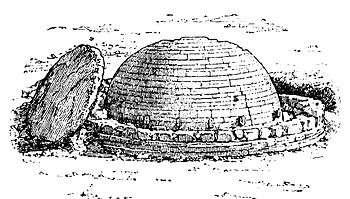Chakdara

Chakdara (Pashto: چکدره) is a town in Lower Dir District of Khyber-Pakhtunkhwa. It is located north of Malakand on the north bank of the Swat River, in a commanding position near the entrance to Swat District and at the entrance to Lower Dir. It is about 130 km (81 mi) from Peshawar and 40 km (25 mi) away from Saidu Sharif, It is the gateway to Lower Dir District.
History

Chakdara has been an important center for the last 3500 years and is littered with remains of the Gandhara grave culture, Buddhist sites, and Hindu Shahi forts. The ancient route from Afghanistan via Nawa Pass and Katkala Pass/Zwalm pul(Bridge) Swat River crosses at Chakdara.
The Mughals built a fort here in 1586, occupied in 1895 by the British, who built the present fort in 1896 and were forced to defend it during the Siege of Malakand in 1897.
Archaeological sites
Buddhist sculpture of the 1st to 7th centuries from nearby sites and Hindu Shahi artefacts are now displayed at Chakdara Museum.Mulla Baba Graveyard(Buddha's Treasury)
Damkot Hill(or)CHURCHILL PEQUOT HILL
The most important site in Chakdara is Damkot Hill. The top of Damkot Hill has been excavated and houses with pottery and jewellery have been discovered. These items are now displayed in the Saidu Sharif Museum.
At the foot of Damkot Hill at Salami there is an early graveyard. Early settlers buried partially cremated bodies surrounded by everyday utensils. The graves were sealed by large stone slabs.
A Buddhist stupa and monastery of the first century AD were excavated by Ahmad Hasan Dani in 1962-65. There are some Buddhist carvings at the foot of the hill. During the Hindu Shahi period a fort was built here which was destroyed in the 11th century. In the 19th century the British occupied this hill. Behind Damkot Hill at Chat pat is the site of a monastery of the late 4th century. The sculpture from this monastery is displayed in Chakdara Museum.
Andannd Dherai
Andannd Dherai, an important Buddhist site, is located 7 km north of Chakdara Bridge opposite to Gul Abad Degree College for Boys near the village of Uchh. According to the Buddhist pilgrim Xuanzang this site was connected with a legend about Buddha. According to the legend, Buddha changed himself into a great serpent lying dead in the valley in order to save the people from famine. The starving people cut pieces from the body and fed themselves.
According to another tradition, Gandhara is also thought to be the location of the mystical Lake Dhanakosha, birthplace of Padmasambhava, founder of Tibetan Buddhism. The Kagyu sect of Tibetan Buddhism identifies the lake with the Andannd Dherai stupa. A spring was said to flow from the base of the stupa to form the lake. Archaeologists have found the stupa but no spring or lake can be identified. Andannd Dehrai Stupa was excavated by Dani. Over 500 pieces of Gandhara sculpture were recovered.
Other sites
Three kilometers from Andannd Dherai Stupa there is the Hindu Shahi fort of Kamal Khan Chena(spring)(چشمہ). It is now in ruins. From this fort a track leads to Nimogram Buddhist Monastery and Stupa. It has three main stupas, which identify three principles of Buddhism; Buddha the teacher, Dharma 4
Sangha (the Buddhist order). Near Chakdara Bridge there are ruins of the Hindu Shahi Period and stupas at Haibatgram, Top Dara and Landakai.
Education

The University of Malakand is located in Chakdara, and other important educational institutions are here, including
- Board of Intermediate and Secondary Education Malakand
- Degree College Gulabad (For boys)
- Higher Secondary School (for Girls)
- FC Public school chakdara
- Madeena Medical Center Chakdara, near THQ hospital Chakdara.
- Govt Higher Secondary School Chakdara(For Boys)
- Chakdara Fort, which is an academy for the Chitral Scouts.
- Swat public school (chakdara campus)
- Cadet college chakdara
- And Other Important Is THQ Hospital
- FEF Girls Degree College
- (Polytechnic colleges for Girls and Boys separately)
http://www.Facebook.Com/Chakdara.Pk Chakdara] Is There
- Faran Public High school Chakdara
- OPF SCHOOL
See also
- Gharai chakdara Nawab Dir & Malak Abdul Rahman khan residency
- DIR MUSEUM
- Subdivisional Courts
- RAHMAN STREET Residency/of
Mayor of Chakdara»(NAZEM)<«Imtiaz khan»>
- University of Malakand
- Timergara
- Lower Swat Valley
- Swat River
- Badwan
- Shawa
- Ouch, Lower Dir
- Dir lower
- Dir (princely state)
- Chat Pat Chakdara, lower DirDir
- Educational Board
- Tehsiel Headquarters Hospitals
External links
- Chakdara Gharai chakdara Nawab Dir & Malak Abdul Rahman khan residency
- Lonely Planet
- Map of Gandhara archeological sites, from the Huntington Collection, Ohio State University (large file)
- Chakdara Museum
- The Story of the Malakand Field Force, by Winston Churchill
Coordinates: 34°39′N 72°02′E / 34.650°N 72.033°E